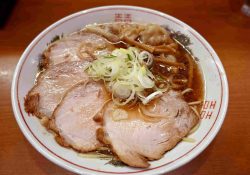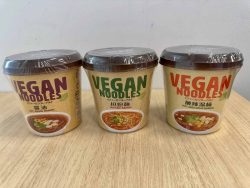
Spicy biangbiang noodles. 1,000 yen.
13:08 JST, December 12, 2023
Nagoya is known for its flat, wide kishimen noodles, but there is a ramen shop in the Aichi prefecture capital that serves noodles even wider. Its name is Atsutamiso Ramen Brew, which sells ramen noodles using homemade miso (soybean paste) broth. Opened in January of this year, the popular eatery is housed in a stylishly renovated 70-year-old residential kominka house. One of the menu items is biangbiang noodles, a spicy mazesoba noodle dish served with homemade noodles over 5 cm wide. I visited Nagoya to taste this dish, which is too wide to slurp.
Located near the famous Atsuta Shrine, the shop is conveniently located only a minute away from Nagoya Railroad’s Jingumae Station. The street is lined with stores renovated from old houses and Brew is found on a corner lot with its monochrome exterior. The street lined with old kominka houses, creating a nice, homely atmosphere.
Miso, salt, numbing-spicy shibikara miso, and biangbiang noodles; the ticket machine at the entrance offers an appetizing array of ramen flavors. I decided to stick to my original intention and purchased the biangbiang noodles (¥1,000). I handed the ticket to Yasuhiro Mishima, who holds the title of chief creator, and he started preparing my order. What surprised me was the width of the noodles: about five times wider than kishimen noodles, they were wider than any other I had ever seen. “I made it the widest I could fit in my mouth,” 32-year-old Mishima said. “We focus on the fun aspects of ramen with the motto of ‘putting fun into form,’ and share it with our customers.” Biangbiang noodles come from China, but he says his product has become a unique ramen far different from its origin.
-
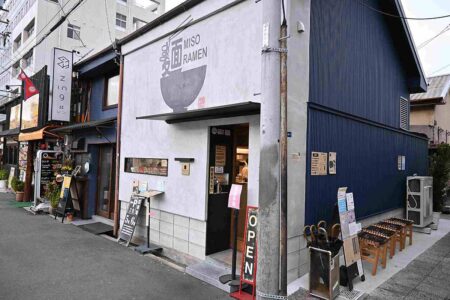
Ramen shop Brew, which opened in a renovated 70-year-old residential kominka house.
-
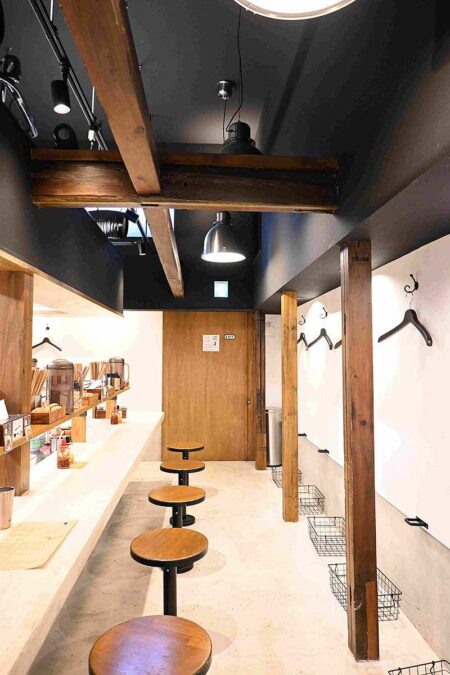
The shop has a counter with eight seats. The house’s old pillars and beams were kept as they are, while the second floor was converted into a vaulted ceiling.
-

Ticket machine
-
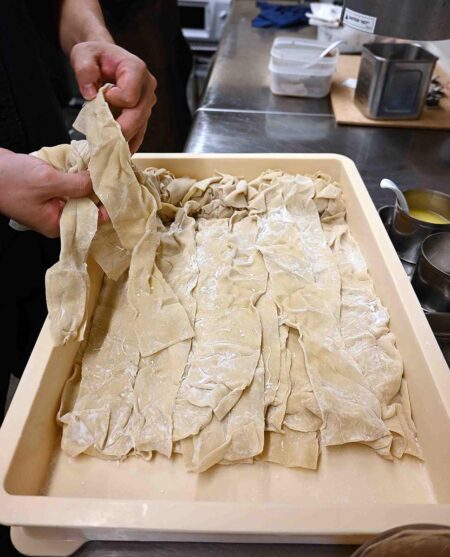
Super-wide noodles in a tray
-

Description of biangbiang noodles on the ticket machine
The completed ramen was distinct in appearance. There is a small amount of sauce at the bottom, which is characteristic of mazesoba noodle dishes. It was topped with minced lamb, spiced tomatoes, fried onions, Kujo leeks, and coconut yogurt. The noodles peeked from underneath. “Please enjoy the various flavors by mixing them little by little,” Mishima said. Starting with the noodles, I tried to slurp them, but found it impossible, so I carried them straight into my mouth. The mild miso sauce matched the noodles and were very tasty. Nothing like homemade noodles! I thought it would take a while for the noodles to cook, but because they are made with a higher water ratio, they can be boiled in 3 minutes and makes them glutinous and chewy.
-
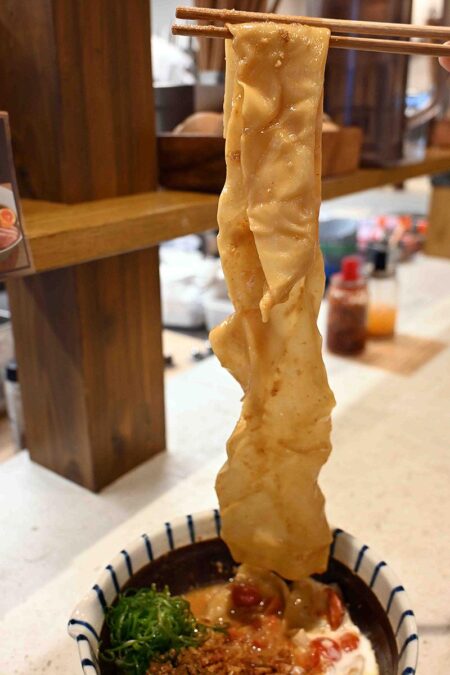
Wide and long noodles that are impossible to slurp
-

Chewy homemade noodles in chicken paitan and miso soup
-
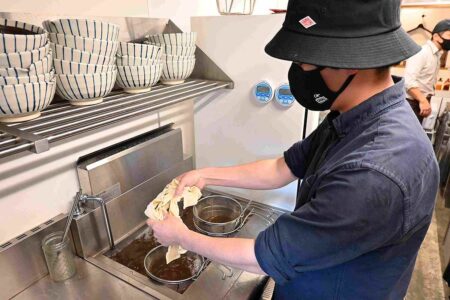
“The noodles are made to be cooked in three minutes,” says Mishima.
-
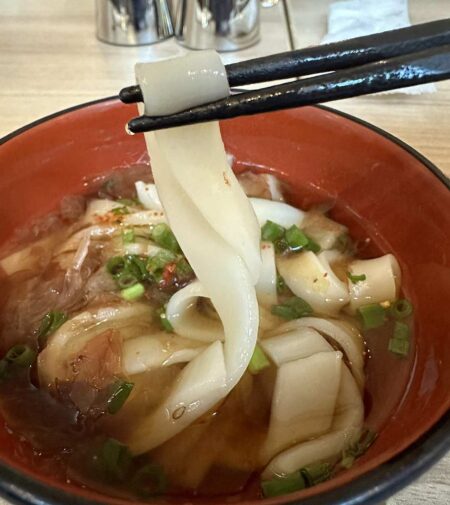
Kishimen I ate in Nagoya
Gradually mixing noodles with the toppings, the spiciness became noticeable the more I ate. The spiced tomatoes contribute to its flavor, seasoned mainly with chili peppers and Japanese sansho peppers, with an addition of star anise and cloves. The other is the lamb seasoned mainly of cumin. Mishima said, “Lamb has a particular flavor, but the miso goes well with a wide range of meats, so I think it is easy to eat.” In addition to the balance of the mild miso and lamb, the spicy aroma of Asian cuisine wafts through the nose. The coconut yogurt melds sweetness with spiciness. The minced lamb mixed in with the chicken paitan miso sauce was delicious to the last bite, and my bowl was empty in no time.
-
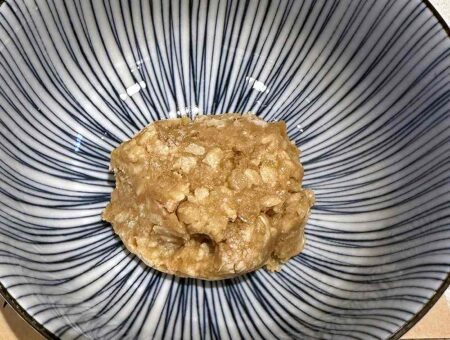
Mishima’s handmade miso
-
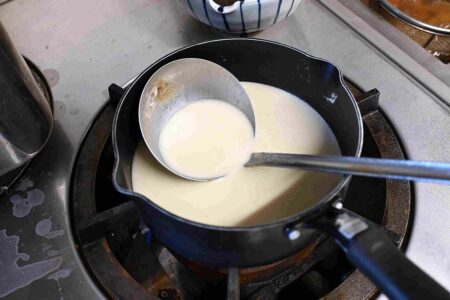
Chicken paitan soup
“This is our miso,” Mishima said, showing me his homemade miso. It is made with only soybeans, rice koji (malted rice) and salt, and is characterized by its sweetness. It made me want to try their signature dish, zenbu-nose (all-topping) miso (¥1,400), their miso ramen dish with every topping, so I bought a ticket and had it made for me. It was another excellent ramen with a high degree of perfection.
-
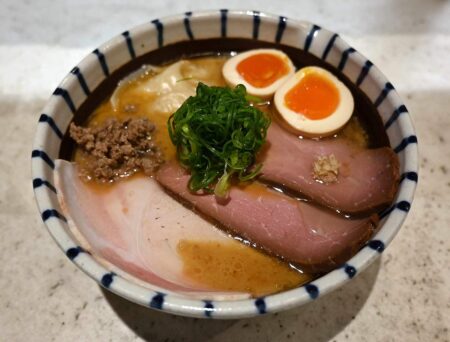
The shop’s signature Zenbu nose miso. The toppings are so plentiful you can’t see the noodles. 1,400 yen.
-
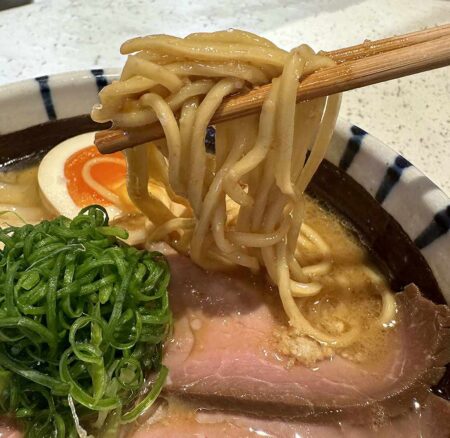
Medium-thick, straight, homemade noodles
-
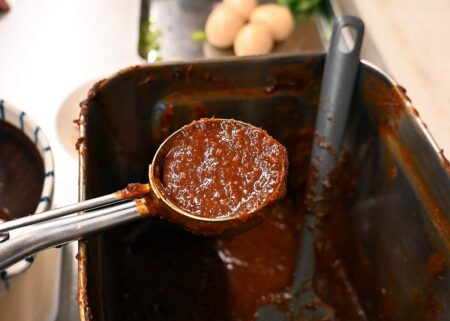
Miso sauce used for ramen
-
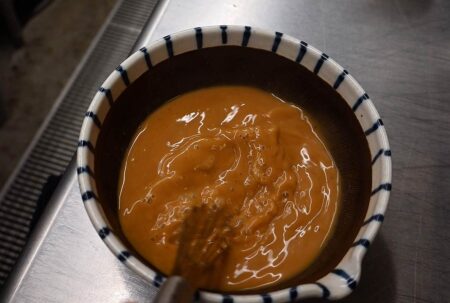
Stirring miso sauce in a bowl
-
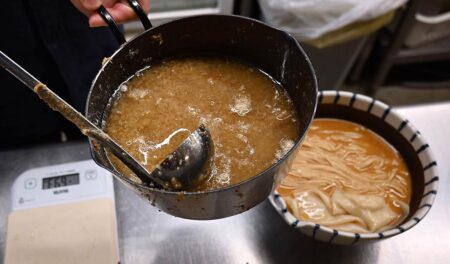
Oil simmered with Hida beef and vegetables. It gives a punch to the mild chicken paitan miso soup.
Mishima explains, “I imagine it as a collaboration between miso from Hokkaido, where I am from, Nagoya Cochin chicken from Aichi Prefecture, and Hida beef (from Gifu Prefecture).” The broth is a combination of paitan soup made by simmering Nagoya Cochin chickens whole and a special sauce made from their in-house miso. Then flavored oil made of Hida beef and vegetables is added, introducing a splash of beef into the soup. It is served with homemade medium-thick straight noodles. Since the miso is rich with rice malt, you can also enjoy a crunchy texture. The zenbu-nose ramen is covered with topping after topping: three pieces of chashu (two slices of Hida beef and one slice of pork loin), beef soboro (minced meat), smoked egg, Kujo leeks, wontons, and grated ginger. The noodles are obscured by all the toppings. “With all the minced beef, the chashu, the smoked egg and more, the taste changes with where in the bowl you eat from,” Mishima said. “I hope you enjoy the various flavors.”
Handmade miso from Hokkaido
-

Mishima, left, who says “having fun is our motto,” and staff member Naoki Fukada. The 30-year-old Fukada is Mishima’s junior at university, and they worked at the same ramen shop when they were students.
-
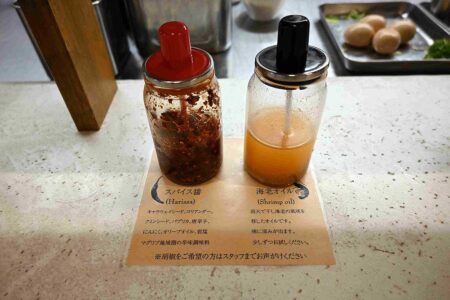
There are seasonings on the table for a change of taste.
-

A table mat with a description of Brew’s passion for ramen
-

Cute wooden ramen spoon popular among women
A native of Asahikawa, Hokkaido, Mishima takes pride in his miso-making. His parents make it every year, and Mishima has helped them since he was four or five years old. Mishima says, “I think the miso I make myself is the best miso I’ve ever tasted.” Brew puts this idea to the forefront: the shop name is Buriyu in Japanese, but Mishima chose Brew for its English name, referring to the process of “brewing” miso.
Mishima is the chief creator of the company Cost Magic, which operates ramen shops, and he and the company president ride the ramen road together. They currently have four shops, beginning with Tori-bancho, which specializes in chicken paitan soup and tonkotsu pork bone broth, followed by Burai, which offers soy sauce ramen with duck, and Burosu with its shellfish salt ramen and beef shoyu ramen. They decided to offer no more than four kinds of ramen at a single shop, and Brew’s ramen has already reached this limit. They plan to open a fifth shop soon and have already announced the name: Bukotsu, which will be a pork paitan ramen shop.

The tip of the burner used for rice dishes is said to be an excellent device to add the aroma of charcoal to the food. Mishima said he liked it when he saw it used by a high-end sushi restaurant. It costs about 40,000 yen.
Everyone in Mishima’s family loves ramen, and they would spend weekends visiting ramen shops together in Hokkaido. Mishima worked part-time at a ramen shop run by the president of his current company while attending a university in Aichi Prefecture where he studied food nutrition. After graduating, he wanted to work for a major food company making potato chips, but employment was limited, and he gave up. He instead went on to work full-time at the ramen shop and later at the company’s newly opened Italian bar-restaurant. He then turned Tori-bancho, a ramen shop located on the second floor of a pachinko parlor in Midori ward, Nagoya, into a popular joint by serving a variety of ramen dishes. Since then, he has continually opened a new store every two years. The company has been unstoppable with every ramen shop becoming a hit, thanks to the president’s management and Mishima on the front line. Mishima always stands in the kitchen of their latest outlet.
Brew often has long queues even if there is no physical line. They have an app-based wait-list where customers scan a QR code at the shop to find out their waiting time and when they should return to the store. Many come from far away to eat there, and on weekends the wait can be up to an hour and a half.
“I am not the type to talk about big dreams,” said Mishima. “I just want to do what is right in front of me to the best of my ability and continue to build popular ramen shops,” expressing his determination.
-
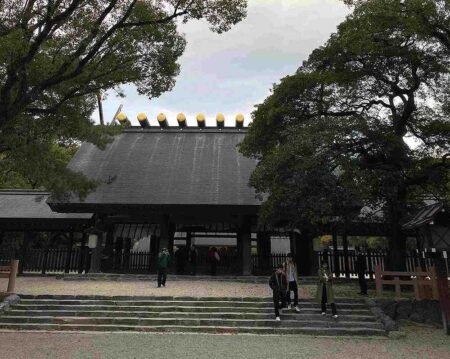
Atsuta Shrine near the shop
-
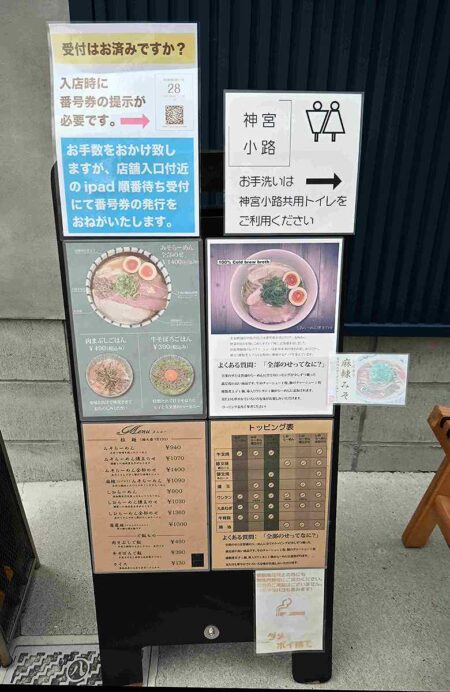
The signboard at the entrance. Customers scan the QR code in the upper left corner information and return to the shop later.
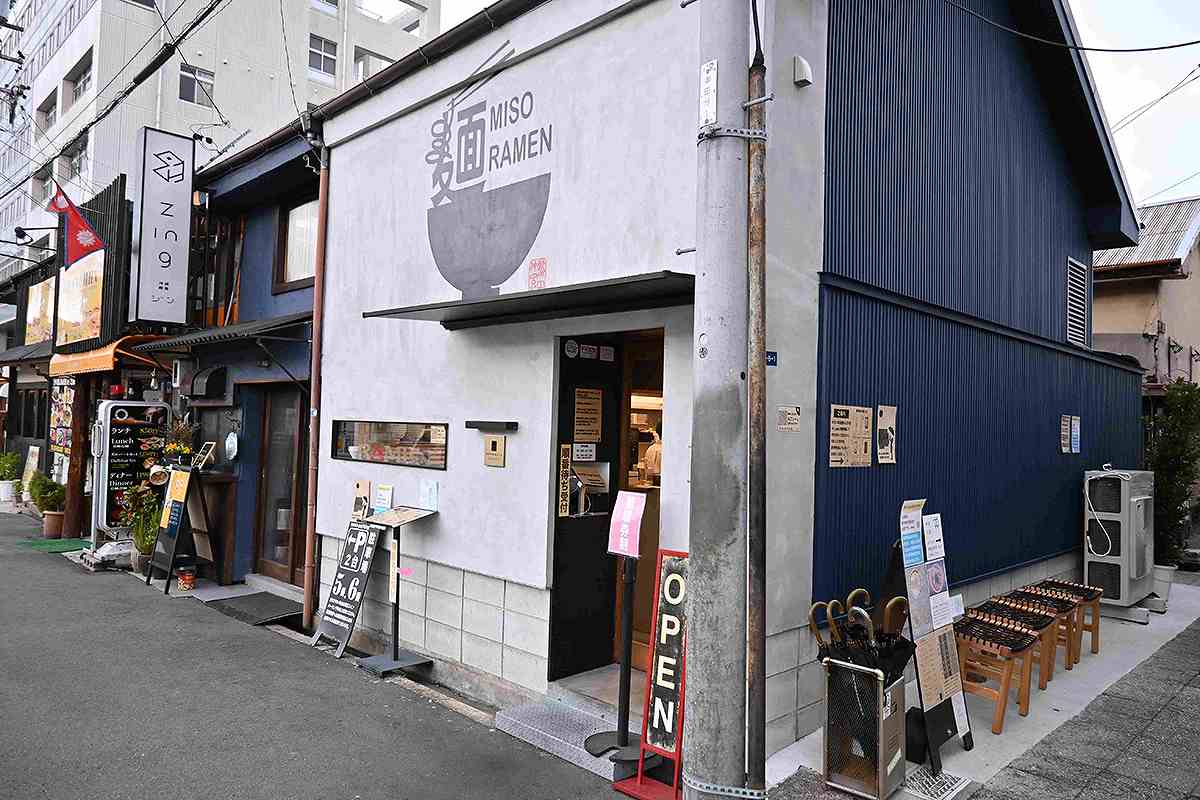
Brew
3-5-6 Jingu, Atsuta Ward, Nagoya City, Aichi Prefecture. Lunch is served from 11:30 a.m. to 3:00 p.m. Also open on Friday and Saturday nights between 6:00 pm to 9:00 pm. Parking available. Closed on Wednesdays and Thursdays.
For more information, visit the store’s official X account. https://twitter.com/atutamisobrew
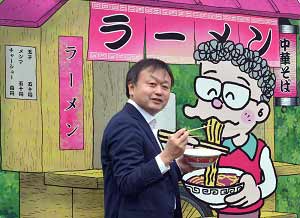
Futoshi Mori, Japan News Senior Writer
Food is a passion. It’s a serious battle for both the cook and the diner. There are many ramen restaurants in Japan that have a tremendous passion for ramen and I’d like to introduce to you some of these passionate establishments, making the best of my experience of enjoying cuisine from both Japan and around the world.
Japanese version
【ラーメンは芸術だ!】5センチ超の幅広麺、名古屋の新名物スパイシーな「熱田味噌拉麺(らーめん)ぶりゆ」

"JN Specialities" POPULAR ARTICLE
-

The Japan News / Weekly Edition (12/12-12/18)
-

English-language Kabuki, Kyogen Entertain Audiences in Tokyo; Portland State University Professor Emeritus, Graduates Perform
-

Noodle Dining Shunsai / Rich Oyster Ramen to Savor at Odasaga; Experienced 68-year-old Owner Creates Numerous Ramen Varieties
-

The Japan News / Weekly Edition (12/5-12/11)
-

People Keep Loved Ones’ Ashes Close in Special Jewelry, Small Urns as Unique Way to Memorialize Them
JN ACCESS RANKING
-

Keidanren Chairman Yoshinobu Tsutsui Visits Kashiwazaki-Kariwa Nuclear Power Plant; Inspects New Emergency Safety System
-

Imports of Rare Earths from China Facing Delays, May Be Caused by Deterioration of Japan-China Relations
-

Tokyo Economic Security Forum to Hold Inaugural Meeting Amid Tense Global Environment
-

University of Tokyo Professor Discusses Japanese Economic Security in Interview Ahead of Forum
-

Japan Pulls out of Vietnam Nuclear Project, Complicating Hanoi’s Power Plans



